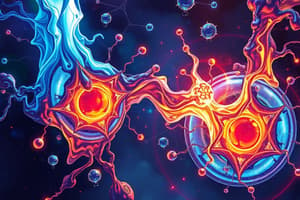Podcast
Questions and Answers
Describe the difference between exergonic and endergonic reactions and give an example of each.
Describe the difference between exergonic and endergonic reactions and give an example of each.
Exergonic reactions occur when products contain less energy than the reactants; an example is cellular respiration. Endergonic reactions occur when energy is absorbed from the surroundings; an example is photosynthesis.
Define energy coupling and give an example.
Define energy coupling and give an example.
Energy coupling occurs when energy from an exergonic reaction is used to facilitate an endergonic reaction; an example is the conversion of ADP and P to ATP (endergonic) and the breakdown of ATP to ADP (exergonic).
Describe how and why negative feedback works.
Describe how and why negative feedback works.
A metabolic pathway is 'switched off' when an end product inhibits an enzyme earlier in its path; this prevents overproduction of certain substances.
Describe how ATP provides energy for cellular processes and how is ATP regenerated.
Describe how ATP provides energy for cellular processes and how is ATP regenerated.
Describe the catalytic cycle of an enzyme.
Describe the catalytic cycle of an enzyme.
Write out the summary chemical equation for cellular respiration.
Write out the summary chemical equation for cellular respiration.
Describe what happens during oxidation and reduction (generally), and give a specific example of each from somewhere in cellular respiration.
Describe what happens during oxidation and reduction (generally), and give a specific example of each from somewhere in cellular respiration.
Describe what happens during glycolysis. Include the molecules emphasized in lecture.
Describe what happens during glycolysis. Include the molecules emphasized in lecture.
Describe what happens during pyruvate oxidation and the Citric Acid Cycle. What substance must be present in the mitochondria for these reactions to occur?
Describe what happens during pyruvate oxidation and the Citric Acid Cycle. What substance must be present in the mitochondria for these reactions to occur?
Describe what happens during the Electron Transport Chain and Chemiosmosis. Explain why these two processes together are called Oxidative Phosphorylation.
Describe what happens during the Electron Transport Chain and Chemiosmosis. Explain why these two processes together are called Oxidative Phosphorylation.
Describe how lactate formation occurs. Identify the cells of animals in which this process occurs, and explain why it occurs.
Describe how lactate formation occurs. Identify the cells of animals in which this process occurs, and explain why it occurs.
Identify the various types of organic molecules that can be used for cellular respiration.
Identify the various types of organic molecules that can be used for cellular respiration.
Flashcards are hidden until you start studying
Study Notes
Exergonic vs Endergonic Reactions
- Exergonic reactions release energy; products have less energy than reactants.
- Example: Cellular respiration, where energy is released from glucose breakdown.
- Endergonic reactions absorb energy; products have more energy than reactants.
- Example: Photosynthesis, which requires sunlight for energy absorption.
Energy Coupling
- Energy coupling involves using energy from an exergonic reaction to drive an endergonic reaction.
- Example: ATP formation (endergonic) from ADP and inorganic phosphate, followed by ATP breakdown (exergonic) back to ADP.
Negative Feedback Mechanism
- A metabolic pathway is inhibited by its end product to prevent overproduction.
- This regulation ensures balanced production of necessary substances in the cell.
ATP and Cellular Energy
- ATP powers cellular processes such as growth and movement.
- Regeneration of ATP occurs through the addition of a phosphate group to ADP.
Catalytic Cycle of an Enzyme
- Energy activation is decreased through the optimal orientation of substrates.
- Enzyme shape changes induce strain, leading to transition state formation.
- The active site may participate in the reaction but returns to its original configuration post-reaction.
Cellular Respiration Equation
- Chemical equation: Glucose + 6Oxygen → 6Carbon Dioxide + 6Water + ATP.
- Represents the conversion of glucose and oxygen into energy and by-products.
Oxidation and Reduction in Cellular Respiration
- Oxidation: Loss of electrons (e.g., glucose oxidized during respiration).
- Reduction: Gain of electrons (e.g., oxygen reduced during aerobic respiration, combines with hydrogen to form water).
Glycolysis Process
- Glycolysis breaks one glucose molecule into two pyruvate molecules.
- Produces two NADH and ATP molecules per glucose.
- Essential for energy production in all living organisms.
Pyruvate Oxidation and Citric Acid Cycle
- Pyruvate enters mitochondria; carboxyl group removed as CO2.
- Remaining 2-carbon molecule oxidized and attached to CoA, forming Acetyl-CoA.
- Acetyl-CoA enters the Citric Acid Cycle, producing NADH and releasing CO2.
Electron Transport Chain and Chemiosmosis
- NADH is oxidized, donating electrons to the carrier chain, releasing energy to pump H+ ions.
- Oxygen combines with electrons and hydrogen to form water.
- Chemiosmosis utilizes H+ gradient to synthesize ATP via ATP synthase, termed oxidative phosphorylation.
Lactate Formation
- Occurs in the absence of oxygen, primarily in muscle cells.
- Pyruvate is reduced using electrons from NADH, regenerating NAD+ for continued ATP production during glycolysis.
Organic Molecules for Cellular Respiration
- Various organic molecules can serve as energy sources, including carbohydrates, which break down into sugars like glucose, further converted to pyruvate.
Studying That Suits You
Use AI to generate personalized quizzes and flashcards to suit your learning preferences.




